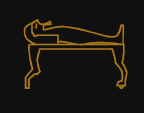|
The empty
tomb of Queen Hetepheres
Who
was Queen Hetepheres?
Hetepheres was closely bonded within the royal family (she is
thought to have been the daughter of Huni (last ruler of the
3rd dynasty)), she was also the sister and wife of Sneferu and
the mother of Khufu. The queen must have been a prominent royal
and must have had considerable power in her own right).
 The
view of the tomb as it first appeared
The
view of the tomb as it first appeared
The
tomb
She is thought to have died during the reign of her son (Khufu)
and was initially buried at Dahshur. Soon after her burial, however,
her tomb was plundered by tomb robbers. Her surviving funerary
goods along with her sarcophagus was transferred to a more secure
tomb near to Khufu's pyramid.
Hetephere's tomb remained safe and undiscovered until 1925 AD.
By a stroke of good fortune, the tripod leg of a photographer's
camera broke through the ceiling of the tomb (the photographer
was part of the expedition led by George A. Reisner, an American
archaeologist). The tomb itself consisted of a deep shaft (99ft)
which then led into a single chamber (this chamber at the time
of its discovery was still sealed with limestone blocks. Inside
this chamber were the grave goods of queen Hetepheres (an inscription
on one of the chairs in the tomb gave her name to the excavators:
'The mother of the King of Upper and Lower Egypt, follower of
Horus, she who is in charge of the affairs of the harem[?] whose
every word is done for her, daughter of the god [begotten] of
his body, Hetepheres'), these goods included:
a large, dismantled, canopy bed; two armchairs; a bed; a carrying
chair; smaller items in gold. copper and alabaster (including
a manicure set); and perhaps most excitingly an unopened sarcophagus
and canopic chest.
 furniture
of the tomb under the canopy also found in the tomb
furniture
of the tomb under the canopy also found in the tomb
Work on clearing the tomb moved very slowly - most of the wood
in the burial furniture had decayed almost completely, it was
only through the patient work of Reiner and his team that later
reconstructions were possible. Reisner delayed opening the sarcophagus
and canopic chest until the rest of the tomb was cleared and
properly recorded. And then on March 3 1927, before a group of
distinguished gentlemen, the order was given to raise the sarcophagus
lid - within a few moments disapointment struck - the sarcophagus
was empty! (At this point Reisner rose and announced that
'I regret Queen Hetepheres is not receiving...'
The canopic chest, however, was not empty - it contained four
packets of viscera. So if her canopic chest was there, why wasn't
her mummy? Reisner himself suggested a possible reason - if her
original tomb had been robbed and her mummy destroyed at that
time, her sarcophagus was sealed and the truth withheld from
Khufu about mother's fate (to prevent him from suffering further
grief).
More recently Mark Lehner
has suggested that the tomb discovered by Reisner was Hetepheres'
original tomb - her mummy was removed a later stage to a burial
in a satellite pyramid (of Khufu's pyramid) where it was destroyed
in antiquity:

(picture from the tomb
- museum of fine arts Boston, pictures of objects from the tomb
- Cairo Museum).
|






